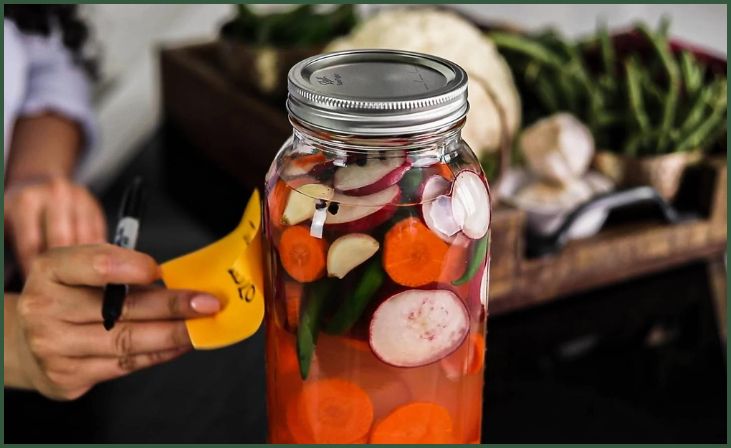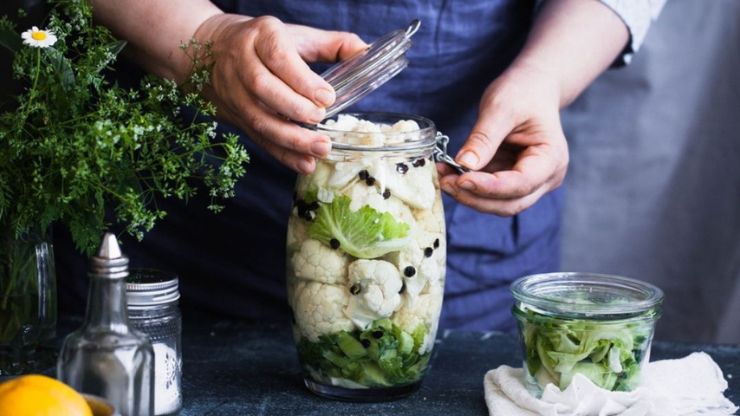Veggies Under The Brine – Are you seeking a method to extend the lifespan of your homegrown, farm-fresh vegetables? If so, let us introduce you to the exquisite practice of brine preservation! By immersing your vegetables in a carefully crafted brine solution, you can effectively uphold their natural freshness and taste.
Within the contents of this comprehensive guide, we are delighted to unveil a treasure trove of 15 invaluable tips. These insights will empower you to effectively sustain the crispness and rich flavors of your vegetables while they remain nestled beneath the brine’s protective embrace.
Table of Contents
ToggleTypes of Brine
Types of brine commonly used in vegetable fermentation include:
- Saltwater Brine: A simple solution of salt and water, commonly used for a variety of vegetables, offering a straightforward method for preserving and flavoring produce.
- Whey Brine: Utilizing the liquid strained from yogurt or kefir, this brine not only aids in the fermentation process but also introduces additional probiotics and a tangy flavor to the vegetables.
- Vinegar Brine: Infusing vegetables with a sharp and acidic taste, vinegar brine is a popular choice for pickling and adds a distinctive tanginess to the final product.
- Sweet Brine: A combination of sugar and salt, sweet brine is often used for milder pickles and results in a slightly sweet and savory flavor profile.
- Spiced Brine: Incorporating various spices such as dill, garlic, or peppercorns, spiced brine infuses vegetables with complex and aromatic flavors, enhancing the overall taste experience.
Also Read: Salt Preserved Limes
Tips To Keep Your Veggies Under The Brine
Choose the Right Container

When selecting a container for your vegetable brining, prioritize materials such as glass, ceramic, or food-grade plastic to avoid any potential reactions with the brine that could compromise the quality of your veggies. Ensure that the container is appropriately sized to accommodate your vegetables, allowing ample space for the brine to cover them completely. This prevents exposure to air and promotes an anaerobic environment crucial for the fermentation process. This is the first tip to keep Veggies Under The Brine.
Use Weights and Tools
Make use of various weights and tools to ensure that your vegetables remain submerged throughout the fermentation period. Employ specialized fermentation weights, small plates, or zip-top bags filled with brine to keep your veggies firmly pressed down. This not only prevents oxygen exposure but also helps in maintaining the vegetables’ texture and flavor by enabling them to ferment uniformly. This is the second tip to keep Veggies Under The Brine.
Create a Brine Barrier
Consider using cabbage or grape leaves as a natural barrier between your vegetables and the brine. Placing these leaves on top of the vegetables helps prevent them from floating to the surface during fermentation. The leaves act as a protective layer, keeping the veggies under the brine and safeguarding them from potential air exposure that could lead to spoilage. This is the third tip to keep Veggies Under The Brine.
Frequent Check-ups
Regularly monitor your fermentation process to ensure that your vegetables remain fully submerged beneath the brine. Perform routine checks to ensure that the weights are adequately pressing down on the vegetables and that no pieces have floated to the surface. Skim off any scum or foam that accumulates on the top of the brine to prevent any contamination that could affect the quality of your brined vegetables.
Maintain Consistent Temperature
Maintain a stable fermentation environment with an ideal temperature range between 60-70°F (15-21°C) to facilitate the growth of beneficial bacteria while inhibiting the proliferation of harmful ones. Fluctuations in temperature can impact the fermentation process, potentially leading to inconsistent results or undesirable flavors in your final product. Consider using a thermometer to monitor and regulate the temperature throughout the fermentation period.
Control Fermentation Time
Ensure that you adhere to a precise fermentation schedule that corresponds to the specific type of vegetables you’re brining. Over-fermentation can result in an overly sour taste and mushy texture, while under-fermentation might leave your vegetables inadequately preserved. Understanding the optimal fermentation time for each type of vegetable is crucial in achieving the desired texture, taste, and overall quality of your brined produce.
Ensure Proper Hygiene
Prioritize impeccable hygiene throughout the entire brining process to prevent the introduction of unwanted bacteria that could potentially spoil your vegetables. Thoroughly sanitize all utensils, containers, and surfaces involved in the preparation process before and after each use. This minimizes the risk of contamination and helps maintain the integrity and safety of your brined vegetables.
Don't just scroll, subscribe!
BuzzTrail's unique web-stories are the cure for boredom you've been waiting for.
Use High-Quality Salt

Opt for high-quality, non-iodized salt without additives or anti-caking agents for your brining process. Choosing the right salt is essential as impurities or additives in low-quality salt can hinder the fermentation process and adversely affect the flavor and texture of your vegetables. Utilize salt that dissolves easily in water and evenly distributes throughout the brine to ensure uniform fermentation and optimal preservation of your produce.
Follow Recommended Brine Ratios
Adhere to the recommended brine ratios specified for the particular type of vegetables you’re fermenting. Maintaining the right concentration of salt to water in your brine is crucial in creating an ideal environment for the fermentation process while preserving the natural flavors of your vegetables. Refer to reliable recipes or guidelines to ensure that you achieve the perfect balance of flavors and textures in your final product.
Experiment with Flavors
Embrace creativity by experimenting with a diverse array of herbs, spices, and aromatics to infuse your brine with unique and enticing flavors. Explore combinations such as dill, garlic, peppercorns, or even chili for an added kick. This experimentation not only enhances the taste profile of your brined vegetables but also allows you to personalize your fermentation process, creating signature flavors that cater to your specific preferences and culinary style.
Also Read: Fermentation Gift Basket
Be Mindful of Air Exposure
Minimize the exposure of your vegetables to air throughout the fermentation process, as prolonged exposure can lead to spoilage and affect the overall quality of your brined produce. Ensure that the weights and brine barrier effectively seal the vegetables from the air, preventing the growth of undesirable molds or bacteria that could compromise the fermentation process and the safety of your final product.
Adjust Brine Levels
Regularly monitor and adjust the brine levels as needed to guarantee that your vegetables remain completely submerged throughout the entire fermentation period. As the fermentation progresses, vegetables may release water, potentially causing the brine level to decrease. Maintain the ideal brine-to-vegetable ratio by periodically adding more brine to the container, thereby preventing any exposure of the vegetables to air that may affect the fermentation process and the quality of your brined vegetables.
Manage Fermentation Pressure
Be mindful of any excess pressure that may build up within the container during the fermentation process. Release the pressure periodically to prevent the risk of the container exploding or the lid popping off, which can lead to potential contamination and spoilage of your brined vegetables. This simple yet crucial step ensures the safety and integrity of your fermentation process and the preservation of your vegetables throughout the entire brining period.
Store in Optimal Conditions
Once the fermentation process is complete, store your brined vegetables in an appropriate environment to slow down the fermentation process and maintain the desired texture and flavor. Opt for a cool and dark storage location, such as a refrigerator or cellar, to preserve the freshness and quality of your brined vegetables. Proper storage not only extends the shelf life of your produce but also allows you to enjoy your fermented vegetables at their peak, savoring their rich flavors and crisp textures to the fullest extent.
Label and Date Containers

Implement a clear and organized labeling system for your brined vegetable containers, indicating the date of preparation to track their shelf life and consumption timeline accurately. Properly labeling your containers helps you keep track of the fermentation period and ensures that you consume your brined vegetables at their peak freshness and flavor, avoiding any potential instances of consuming produce past its prime. This practice promotes food safety and helps you maintain a well-managed and enjoyable brining experience. This is the last tip to keep Veggies Under The Brine.
Also Read: How Does Lacto Fermentation Work
Conclusion
Equipped with this arsenal of expert tips, you are now poised to ascend to the esteemed rank of a brine preservation virtuoso. By ensuring that your vegetables remain securely submerged in the brine, you not only extend their shelf life but also elevate their inherent flavors to new heights. Take the plunge into the captivating realm of brine preservation, and indulge in the exquisite and satisfying tastes of your very own garden-fresh vegetables throughout all seasons of the year!
FAQs
How long can I store brined vegetables?
How long can I store brined vegetables?
Properly brined vegetables can be stored for several months, ensuring prolonged freshness and taste.
Can I use different types of salt for brining?
Can I use different types of salt for brining?
While sea salt is commonly preferred, any non-iodized salt without additives can be used for successful brining.

